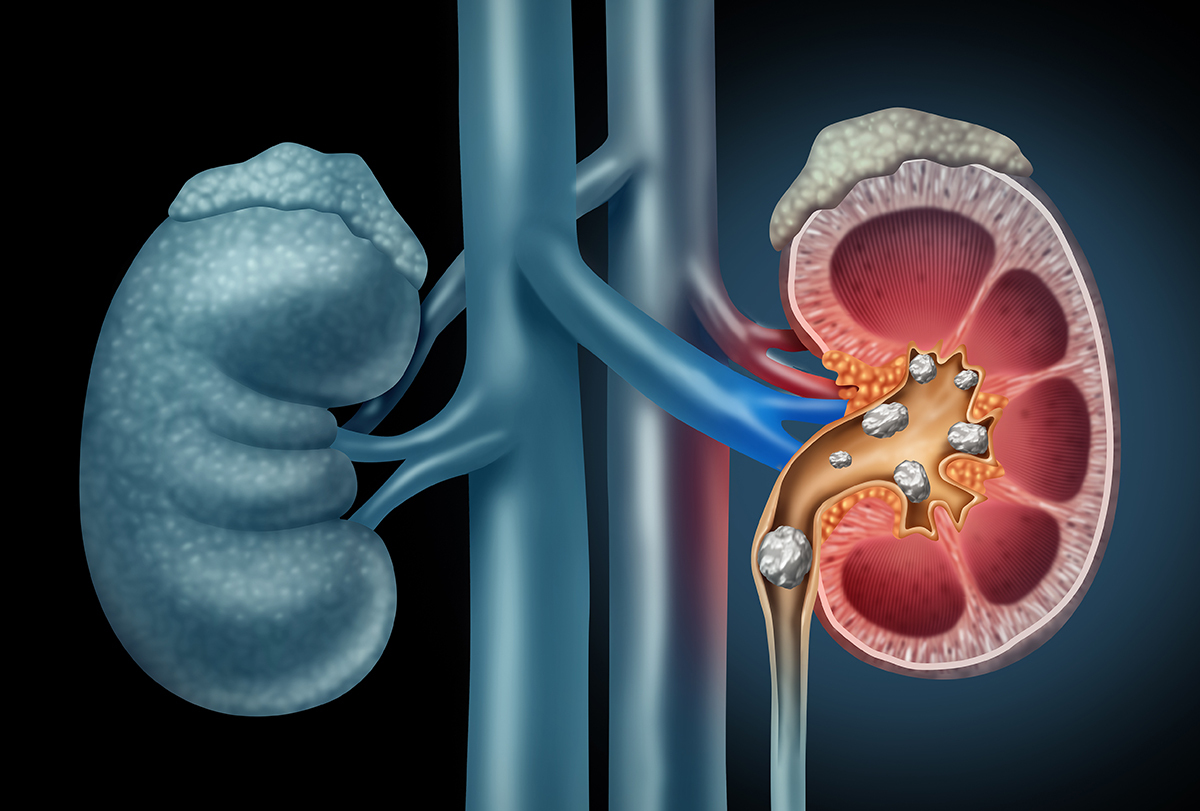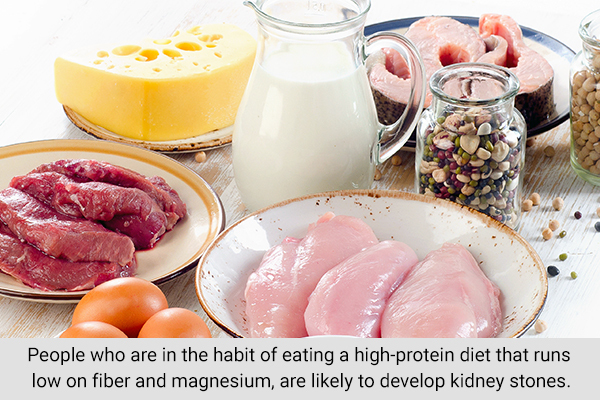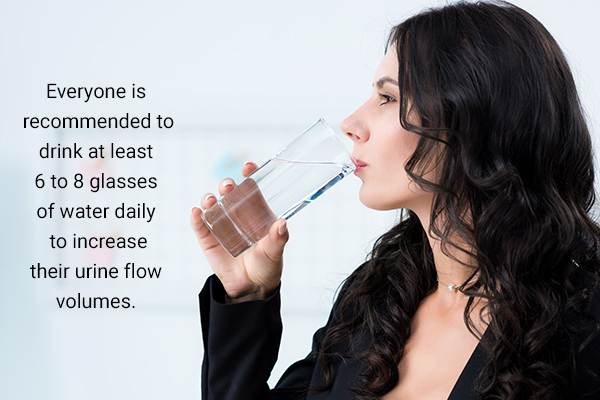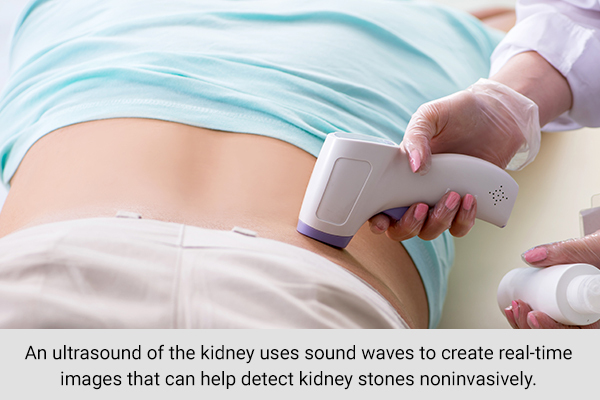In this article:
Kidney stones are a very common health problem. They form from the chemicals in urine, such as uric acid, phosphorous, calcium, magnesium, and oxalic acid.

Medically referred to as nephrolithiasis, stone formation happens when salts and minerals in the urine become crystallized by sticking together. These crystals continue to aggregate and build up over a few weeks or months into hard rock-like deposits or stones.
Kidney stones range in size from a fraction of an inch to several inches. Small kidney stones (0.2 inches or less than 5 mm) can pass through the urinary tract and out of the body with little or no pain. However, larger stones can be quite painful, block the flow of urine, and cause blood in the urine and other symptoms.
Prevalence of Kidney Stones
Kidney stones are quite common, with around 3 in 20 men and up to 2 in 20 women developing them at some stage of their lives. This condition also has a geographical prevalence (i.e., the “stone belt” is the southeastern states of the United States).
Men are more prone to kidney stones than women, and they are most likely to occur between the ages of 20 and 50, according to the National Kidney Foundation. (1)
Types of Kidney Stones
The four major types of kidney stones include:

- Calcium stones: Excessive amounts of calcium in the urine accounts for 80 percent of all kidney stones. These calcium stones are formed when the calcium that is not used by the bones and muscles combines with other substances, such as oxalate and phosphate, in the urine. To a lesser extent (20 percent), calcium stone formation results from the lack of adequate calcium excretion by the kidneys.
- Struvite stones: These stones develop in the wake of an infection and comprise magnesium and the waste product ammonia. Struvite stones can grow to be quite large rather quickly and thereby cause urinary blockages. These stones are mostly prevalent in women who are prone to urinary tract infections. They are predominantly seen in individuals with chronic indwelling urinary catheters, those who are debilitated, and those who have special bacterial infections (the bacteria often are Proteus mirabilis and Providencia).
- Uric acid stones: Such stones are more common in men than women, with elevated blood uric acid levels (hyperuricemia), a high-protein diet, and dehydration (insufficient water intake or excessive loss of fluids). You may inherit certain genetic factors that predispose you to this problem. Hyperuricemia may be the result of chemotherapy treatment for certain cancers in which, when the cells die (lysis), large amounts of uric acid are released.
- Cystine stones: Cystine stones are relatively rare and usually develop in people grappling with a genetic disorder that goes by the name of cystinuria. Cystine is an amino acid that occurs naturally in the body. Cystinuria is characterized by an increased excretion of this amino acid from the kidneys such that the urine contains unusually high levels of cystine.
Causes and Risk Factors for Developing Kidney Stones

One of the functions of the kidneys is to remove waste and fluid from your blood, which are filtered and excreted in the form of urine. Kidney stones occur whenever there is an excess of crystal-forming waste substances in your urine and a lack of water needed to dissolve them.
Both genetic and environmental factors as well as certain medical conditions and metabolic problems can lead to the formation of kidney stones: (2)
- Kidney stones are a common occurrence in people who make less than 1 liter of urine per day.
- People with hypercalciuria/hypercalcemia (excess levels of calcium in the urine/blood) figure among those individuals with an elevated risk for nephrolithiasis. Hypercalciuria can result from medical conditions such as hyperthyroidism, hyperparathyroidism, sarcoidosis, and malignancies such as multiple myeloma and bone invasion by a tumor. There are also cases in which cause for the stones is unknown (idiopathic).
- Prolonged or excessive intake of calcium or vitamin D supplements can dangerously increase calcium levels in your blood and urine, paving the way for calcium crystallization in the kidneys.
- Consuming large amounts of oxalate-rich foods such as spinach, nuts, chocolate, and certain teas can lead to hyperoxaluria or excess levels of oxalate in the urine. These excessive oxalates then bind with calcium.
- People who cut back on their dietary intake of calcium in the hopes of preventing kidney stones might end up making themselves increasingly vulnerable instead. Lack of dietary calcium intake can trigger the parathyroid glands to activate the resorption of bone, resulting in hypercalcemia and increased risk of calcium stones.
- Hyperuricemia can increase the risk of gout or uric acid stones. Uric acid stones are an imminent threat for people suffering from hyperuricosuria, a medical condition associated with problematic uric acid metabolism.
- Cystinuria is a rare genetic disorder characterized by excess production of cystine, which can eventually lead to the development of cystine stones.
- Kidney stones may run in your family (familial).
- If you have already had one or more kidney stones in the past, you are increasingly likely to develop another in the future. There is an old adage that says, “once a stone former, always a stone former.”
- People with poor fluid intake or dehydration tend to have increasingly acidic urine, which is conducive to the formation of kidney stones. This is particularly true for people who live in warm climates and are prone to increased evaporation and perspiration via the largest organ of the body, the skin.
- Structural problems (such as cysts, remnants, and appendages) that cause pooling of urine and infection in the kidney may also cause kidney stone formation.
- Some medications taken for other conditions, such as diuretics (thiazides), calcium-based antacids (Rolaids), antiretroviral medications, and seizure medications (Topomax), can lead to kidney stone formation.
- Kidney stones are more prevalent among men than women.
- Unrestricted consumption of sugar-rich or phosphate-rich foods has also been linked with an increased incidence of kidney stones.
- Eating a diet that runs high on sodium can increase the amount of calcium your kidneys must filter, thus making you increasingly susceptible to kidney stones.
- People who have grappled with gastric bypass surgery, inflammatory bowel disease, or chronic diarrhea often undergo changes in their digestive process that adversely affect the absorption of calcium and water in the body, increasing the risk of stone formation.
- People aged between 30 and 50 are most commonly affected by the scourge of kidney stones.
- Overweight and obese people are also more susceptible to this problem than people who weigh within the optimal limits.
- Other medical conditions that can precipitate the development of kidney stones include renal tubular acidosis, milk-alkali syndrome, and prolonged immobilization.
- People who are in the habit of eating a high-protein diet that runs low on fiber and magnesium are also likely victims.
- People with certain structural deformities in the urinary tract that cause the pooling of urine and infection in the kidney are also at an increased risk of nephrolithiasis.
Symptoms of Kidney Stones

Kidney stones can form in either one or both kidneys and can grow to different sizes, ranging from as small as a grain of sand and pea-sized to as large as a pebble. On occasion, the dissolved salt and minerals within the kidney can combine to give rise to relatively large stones that are the size of a golf ball!
So long as the kidney stone remains immobile within the kidney, it is unlikely to trigger any pain or other noticeable symptoms. Detecting the presence of such stones is usually a happenstance wherein it is picked up by an X-ray or scan done for another reason (if calcium based).
However, if the kidney stone starts to move around within the kidney or passes into the ureter, the tube that carries urine from the kidney to the bladder, you are likely to experience bouts of excruciating pain in and around the flanks known as renal colic.
Not everyone with kidney stones has to brave out this pain. If your stone is small enough, chances are you might pass it out of the urinary tract without even noticing it. However, larger stones can be more difficult and painful to eliminate through your urine. As these considerably sized stones move down the narrow and delicately structured ureters, they can cause painful spasms and irritation.
Moreover, as the stone travels along the urinary tract, it can obstruct the natural flow of urine, causing inflammation in the kidneys. The swelling, in turn, activates the nerves to send signals to the brain that are interpreted as an intense, visceral pain located between your shoulder blades.
Safe to say, the larger your stone, the more distressingly conspicuous the symptoms.
The commonly reported symptoms that follow in the wake of kidney stone formation include:
- Sharp pain emanating from either side of your back (flank) that radiates to your lower abdomen and groin
- A relatively dull ache between your shoulder blades
- Nausea or vomiting
- Unusually frequent need to urinate
- Mucus in the urine
- Gravel-like substances passed in the urine
- Pink, red, or brown blood in the urine (known as hematuria)
- Urine that looks cloudy and/or smells unusually foul
- Pain or burning sensation while urinating
- Strong urge to urinate but excreting only small amounts
- Fever and chills when your kidneys have been infected (known as pyelonephritis)
Treatment Options for Kidney Stones

If your kidney stone happens to be less than 5 mm in diameter, drinking ample amounts of water can be sufficient to excrete the stone naturally out of your system without any medical intervention.
In fact, everyone is recommended to drink at least 6 to 8 glasses of water daily to increase their urine flow volumes. The pain associated with kidney stones is usually excruciatingly severe at its onset and may require carefully administered narcotic medications for relief.
As the condition persists, the pain mitigates to a milder degree and can be managed by nonsteroidal anti-inflammatory drugs (NSAIDs), such as ibuprofen (Advil, Motrin IB), acetaminophen (Tylenol), and naproxen sodium (Aleve). If you have a known kidney disease, you must avoid ALL NSAIDs. The prolonged and excessive use of NSAIDs can cause kidney dysfunction.
The doctor may also write down a prescription for an alpha-blocker, which works by relaxing the muscles of the ureter to facilitate easy and painless passage of the stone.
Doctor-assisted removal of kidney stones (known as a urologist) may be needed if:
- The stone is too large to pass on its own.
- The stone leads to severe pain or bleeding.
- The stone gets stuck within the urinary tract in such a way that it blocks the flow of urine, potentially causing an infection.
There are a number of treatment options that are regularly used for the elimination of kidney stones:
- Extracorporeal shock wave lithotripsy (ESWL) involves the use of lithotripters or lasers to generate targeted high-energy shock waves. These waves are directed at the kidney stone under imaging guidance, leading to the disintegration of large stones into smaller fragments that patients pass on their own.
- Smaller stones in your ureter or kidney can be directly removed from the ureter by using a ureteroscope, a fine instrument inserted into the ureter via the bladder.
- Percutaneous nephrolithotomy is a minimally invasive procedure that involves the insertion of a needle-thin instrument called nephroscope through a small incision in your back that is made to create a passage to the kidneys. This instrument has a camera on the tip and can be used to locate and break up kidney stones or remove them altogether.
- Your doctor may feel the need for surgery to remove benign tumors from the parathyroid glands to stop the overproduction of parathyroid hormones that often results in calcium phosphate stones.
Diagnosing Kidney Stones

After conducting a physical exam and a comprehensive assessment of your medical history, your doctor can conclusively verify the existence of a kidney stone by ordering a string of tests. These include imaging tests to check the kidneys, the ureters, and the bladder for stones.
For instance, an abdominal CT scan helps ascertain the presence of a kidney stone, its location and size, signs of urinary blockage, and the state of the organs that make up the urinary tract and those that adjoin it.
Unlike standard X-rays that often miss out on smaller kidney stones, or if they are not calcium based, a CT scan is largely effective in detecting even the tiniest anomaly.
Similarly, an ultrasound of the kidney uses sound waves to create real-time images that can help detect kidney stones noninvasively. Ultrasound is preferred over CT scans in the case of pregnant women to avoid subjecting them to unnecessary radiation.
X-rays, including an intravenous pyelogram (IVP) where dye is injected into the bloodstream before the X-ray, are taken.
Another lesser-known imaging technique to visualize abnormalities of the urinary system involves injecting dye into an arm vein to outline the kidneys, ureters, and bladder. The movement of the dye as it passes through the urinary tract is monitored via X-rays (IVP) or by obtaining CT images (CT urogram).
Of all these tests, ultrasound is the safest option as CT scans and IVP employ the use of dyes that can cause kidney infections, kidney dysfunction, or allergic reactions to the dye (radiocontrast) in people with an already compromised renal system.
Additionally, certain medications can amplify the damaging effect of this dye on your kidneys. Thus, your radiologist should be informed about any medication that you are on before going for either of these tests.
The doctor may also conduct a set of urine tests, which may include:
- Urinalysis, which entails analyzing a urine sample under a microscope to look for stone-forming crystals, blood, white blood cells, and bacteria and to determine the urinary pH (measures the acidity of the urine)
- A 24-hour urine collection test, which will require the patient to collect urine samples over a 24-hour period in a container
In conjunction with these urine and image tests, your doctor may test your blood for excessive levels of calcium, phosphorous, magnesium, uric acid, thyroid hormones, and parathyroid hormone, to evaluate kidney function, and to check signs of anemia or infection.
Once the stone is excreted through the urinary passage, you will be required to deliver it to your doctor for further analysis. The doctor will examine the composition of the stone in the lab, which might reveal its probable cause. Once your doctor is equipped with all the necessary information, he/she can lay down an appropriate treatment plan for other stones that may be present as well as a plan to prevent a recurrence.
Complications Associated With Kidney Stones
Kidney stones that remain inside the body for too long can lead to many complications. For as long as the kidney stone remains lodged within the ureter, you may continue to excrete reduced or insufficient amounts of urine from the body.
Such prolonged urinary obstruction can pave the way for subsequent kidney infection and chronic renal damage.
When to See a Doctor
If you feel that the pain and discomfort have exceeded your threshold, seek the help of your healthcare provider who can guide you through the ordeal in the best possible way.
Prompt medical attention becomes the need of the hour if you experience:
- Debilitating pain that makes it difficult to sit still or find a comfortable position
- Pain that is accompanied by nausea and vomiting
- Pain accompanied by fever and chills, which can be an indication of infection
- Bloody urine
- Difficulty passing urine
Your doctor will refer you to a urologist to manage stones that are too big, incapable of passage, or associated with complications (hematuria, infection).
Final Word
Although the pain associated with kidney stones is not persistent and usually comes in waves, it can be severe enough to warrant a visit to the emergency room. The larger the stone, the greater will be the pain while passing it.
Moreover, the intensity and location of the pain may change as the stone makes its way through the urinary tract.
You should follow your doctor’s advice and diligently stick to the recommended treatment in order to get rid of the stone and prevent new ones from forming. If a kidney stone obstructs the urinary passage for far too long, it can give rise to a number of serious complications including kidney infection and renal damage.

- Was this article helpful?
- YES, THANKS!NOT REALLY


